The Evening Journal.
Ottawa, Wednesday, December 2nd, 1903
OTTAWA UNIVERSITY DESTROYED BY A FIERCE FIRE EARLY THIS MORNING
Splendid Pile of Buildings a Total Wreck. Fire Spread with Lightning Rapidity and Priests, Students and Domestics had Narrow Escapes from Death. A Number Injured Jumping from Windows. Graphic Stories of Those who Escaped. Loss Will Double the Insurance. Gross Loss About Half a Million Dollars.
OTTAWA UNIVERSITY AN
ABSOLUTE WRECK
Loss of Buildings $250,000.00
Loss of Contents
Including the
Handsome Chapel,
Library, according
To Rev. Father
Emery’s estimate $250,000.00
Total Estimated
Cost $500,000.00
INSURANCE
The loss is covered
To the extent of $200.000.00
INJURIES
Rev. Father Fulham seriously injured about the back, will likely recover. Jumped from a fourth story window. Father Boyoux seriously injured about the chest and back. Will likely recover. Jumped from a fourth story window and missed the net. Father McGurty badly burned about the head, shoulders and arms. Ran through the fire to get out. Miss Cordelia Tremblay, an employee of the college, leg broken and otherwise injured. Jumped out of fifth story window and missed the net. Mrs. H. Bastien, St. Hyacinth, Hull, left arm and right leg broken. Jumped from fifth story window. Father O’Boyle, hair and face burned. Ran through fire to get out. Dominic Collin, student, St. Boniface, Man., eye injured by broken spectacles. Jumped from fourth story window. Miss Josephine Dupuis, jumped through a window and is now at the Water Street Hospital. Sustained cuts on the head and face.
A smoking mass of ruins is all that remains to-day to represent what was yesterday the University of Ottawa. The splendid pile of buildings which covered the block of land embraced by Wilbrod, Theodore, Waller and Cumberland Streets, was early this morning completely destroyed by fire. Of the handsome structure, which was one to which visitors were pointed with pride, nothing remains but crumbling walls. One part of the building occupied by the chapel and junior dormitories is levelled to the ground. (Last sentence unreadable)
The gross loss will be considerably over a quarter of a million dollars. The burned buildings are insured at $245,000.00, but the actual value so far as replacement is concerned may be put down as considerably in excess of that figure.
No one saw the fire start, but it is believed to have had its origin in the Academic Hall in the East wing. It broke out about 7:45, when the students were at breakfast. Ten minutes later and the two hundred and twenty-five students in residence were fleeing for their lives. It is doubtful if a fire ever spread as rapidly.
There was not a priest or student who saved a thing. Trunks, clothes, and every sort, even overcoats went to the flames. Many students had money in their trunks. Very few even enough money to get home with. Seventy-five percent of the boarding students come from the United States and far away points in Canada. These for the present are homeless. Most of these still get money from home will go to hotels. Not a few have already been offered the shelter of hospitable homes in the vicinity of the College.
The cause of the fire will probably never be known. But it is suspected that it started in the amusement hall, where last night the students held a play, in which electric effects, Chinese lanterns and some fireworks were used. The play did not end till after 12 o’clock.
It is supposed that either some of the electric connections about the stage were defective or that some of the fire from the fireworks smoldered and finally broke out in the morning. Another theory is that the fire began shortly after the students went to bed and was only discovered in the morning. But that theory is hardly a likely one, as the reflection of a fire during the night would have only been certain to have been seen by passers by outside.
The fire made a great smoke, which attracted thousands of people from all parts of the city. Expressions of regret were general that such a splendid educational institution should be destroyed.

Ottawa University buildings in 1886

Ottawa University buildings in 1900
WHY IT SPREAD
The firemen were on the spot as quickly as could be expected, but it was from the start that they would not have a chance to save anything. There are two reasons assigned for the terrific speed with which the fire swept its way from end to end of the big building. The first is that corridors ten feet wide run the full length of the building on each flat. The fire thus had a series of tunnels through which it drew itself from room to room and from wing to wing. The second reason is that the building had a very large amount of woodwork through it and as most of this was old it served as tinder to the flames.
NARROW ESCAPES
There were many narrow escapes from death. Two priest and a serving woman were badly injured by jumping from upper stories. Details of these injuries will be found in another column.
HOW THE FIRE WAS FOUGHT
BATTLE TO KEEP FLAMES IN WALLS
Fire Spread So Rapidly That Brigade Were Powerless. What The Chief Says
The fire was first discovered about 7:45 just as the students were leaving the dining hall, where they had breakfast. Some of them had reached their rooms when the first alarm of fire was given. The fire appeared to be coming from the piano room, where there had, as already stated, been an entertainment last evening.
Mr. Percy Gilmour, who lives at 179 Wilbrod street, was the first to give the alarm. He, it may be stated, also gave the alarm when the college fire occurred three years ago. Mr. Gilmour was just going to his stables on Wilbrod street to feed his horses when he noticed the fire breaking from the west wing of the college. "I saw this smoke rolling out," said Mr. Gilmour, "and I at once made for the alarm box at the corner and pulled it. Then I turned around and in but a very few minutes it seemed Chief Provost drove along and pulled the alarm again. When I saw him do this I ran towards the building and by that time the fire was coming out of the windows in the three wings. It looked to me as if the fire started in three different places all at the same time. If it did not, it certainly had spread very quickly. The first of the brigade got to the scene rapidly, but quick as they got here the fire spread more rapidly. It was, as I said, coming out of the windows in all directions. So were the students. They were climbing out of the windows on all sides. Some of them jumped from the third and fourth stories, while others held on to the ledges of the windows until the firemen shoved up the ladders or held the net for them to jump into. The firemen, once they got here worked well, but them seemed to me, to be slow in getting to work."
CHIEF PROVOST
Chief Provost says that he was just coming back from the fire in New Edinburgh when he heard the alarm and drove up by way of the box.

When he got to the corner of Cumberland Street and Wilbrod he saw the flames coming out of all windows in the building which was a mass of fire. The students were getting out the windows when I arrived. “The first thing I put the firemen to do was to save the people in the College. This was done by means of ladders and lifesaving nets which were worked very successfully. A large number of students were saved in this way. In one corner, I saw them save five men who jumped out of the windows in as many minutes. They also caught two women. We did this first and were well assisted by the students who were a plucky lot of fellows.
We were considerably handicapped by the fact that number four, five and six stations were at work in New Edinburgh and were just gathering up their hose when I sent in the alarm to call them. They got here very quickly, however as soon as they did, I set them to work. I had the engines here from the first and they did excellent work. Had it not been for the engines, the church, science hall and much more would have been burned. I certainly think that the engines saved the fire from spreading".
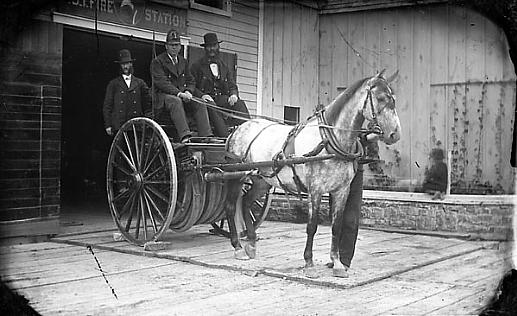
Fire reels
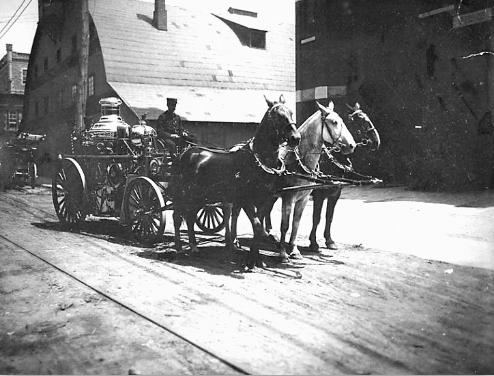
Engine
HOW FIGHTING WAS DONE
The brigade was divided into two sections. The upper town portion, under Deputy Chief Stanford, placed the Jubilee on Cumberland Street at the east end of the building, and fought the fire from Theodore Street, while the lower town portion of the brigade worked under Deputy Chief Latimer from Waller Street and Wilbrod. The Victoria engine placed on Waller Street. From each engine there were three streams. Two streams were taken from every hydrant. Fortunately, the pressure was good and augmented by the engines, the streams were easily thrown over the top of the science hall, which is six stories high.
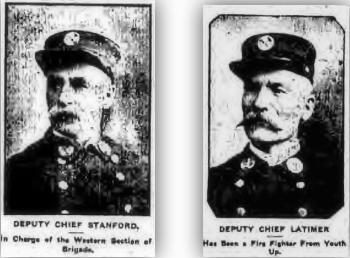
There has never been a fire in Ottawa where the building was so full of flame. Every thing was burning, making the interior a seething furnace. It was the hottest fire while it lasted, that had been in Ottawa for years. The interior of the building was built of inflammable materials and was purely a tinder box. Once fighting, the firemen had to stay on the ground and direct the streams into the windows.


Courtesy of the Ottawa University Archives, AUO-PHO-NB-38A-1-78.

The building was doomed from the time the alarm was pulled, as it was on fire from the cellar to the roof. Streams were directed from all sides but they did not seem to check the fire. The only thing that remained was to keep the fire confined with in the walls. This was done but it was a struggle. Time after time the roof on St. Joseph’s Church started to steam as did also the cornicing on the front of the Science Hall. Both buildings were on opposite sides of the street but both stood in immanent danger of catching fire. The firemen worked the hose up by pulling them up by ropes, and got onto the roof where the whole of the front cornice of sheet iron had to be torn off to get at the fire which had started to smolder underneath. Several times the fire caught in the bell tower of the church, but this fire was extinguished with Babcock chemical extinguishers.

The Science Hall then on Wilbrod.
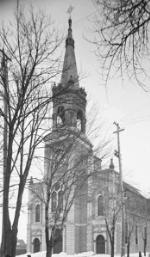
St. Joseph's Church.
DANGEROUS WALLS
Towards the end of the blaze the danger of the walls falling began to threaten the firemen and they had to keep a distance away. First the ceilings began to fall and every time they did, a cloud of dust, sparks and smoke covered the spectators. Finally, the rear wall of the Chapel began to totter and down it came. No one was caught under it but many had a close call. Then a few minutes later the front wall of the Chapel fell out towards the street. The firemen by their discretion, were saved from injury in this collapse. The fire started at 7:45 and by 6 o’clock there was nothing left but the hard wall.

OPINION
Mr. P. J. Coffey, the county registrar, who went to school at the university, in dissecting the way the fire was handled, said that he did not think that it was possible to save it, also it had got under way. The building, he said, was so constructed that it was almost impossible to check a fire if once it got started. The interior was all finished in soft wood and as the building had been built in sections without fire walls between, the fire had full scope in the long corridors as soon as it got headway.
HAD TO JUMP TO SAVE LIVES
THRILLING INCIDENTS AND NARROW ESCAPES
Priests, Students and Domestics Injured While Jumping 2nd, 4th and 5th Stories
The fire did not fortunately take a toll of death, as well as a loss, financial, but death was very near to many during the early part of the blaze. Priest and students had to jump for their lives and the progress of the blaze was replete with exciting incidents.
As a result of being cut off and having to jump to safety, Rev. Father Boyoux, a priest lately from France, and a professor of the college, is lying in critical condition in the Water Street Hospital, while Rev. Father Fulham, prefect of the senior department play ground, is severely injured about the back. Father McGurty, curate of St. Joseph’s church, while escaping was burned about the head. Two female servants are severely injured.
Father Boyoux, whose room is in the fourth flat of the central wing, had to dress hurriedly. Before he was ready the flames were in the hallway outside. Below about 15 feet was the roof of the long verandah, on which the priests take their exercises. He tried to jump to safety onto this, but the roof was slippery and he could not get a hold. He fell onto his left shoulder on the verandah roof and bounced down to the ground, where landed on his right shoulder and the side of his face. He was picked up and taken to the Water Street hospital.

MISSED THE NET
One of the most exciting incidents of the day that which occurred, when Cordelia Tremblay, an old female servant, who had been a long time in the employ of the University, jumped from the 5th story. She jumped too far out, and missing the life nets, fell with a crash to the hard ground, which had not sufficient covering of snow to break the force of the fall. She was picked up unconscious and carried to a house on Wilbrod Street, where it was found she had broken a leg and had been injured internally.

Mrs. H. Bastien, a domestic, whose home is in Hull, jumped from the same window. She landed in the net, but bounced out. In her fall she broke her left leg and right arm. Dounat Collin, a student from St. Boniface, Man., jumped from a 4th floor story window. He escaped with a light injury. A number of others sustained minor injuries. Miss Josephine Dupuis, a domestic, jumped from a second story window. She sustained cuts on the face and was badly bruised about the body.
NARROW ESCAPES
A thrilling story of a narrow escape from suffocation is told by Simeon Harvey, a student who was asleep in the dormitory and awakened to find his bed burning. Giving his story to a reporter, Mr. Harvey said "we had given a play last night in the college hall and as a consequence, myself and a number of others did not get to bed until about two o’clock this morning. As usual, the father came around about six o’clock and tried to wake me, but I was too tired and told him I was going to sleep a while longer. I went to sleep again and was enjoying some pleasant dreams, fancying I heard music around me. Fortunately, my dream was cut short and awaking I found the fancied music to be the crackling of flames in the corridor and in my room. The worst of all was the sheet on my bed had begun to burn, and had I slept a few minutes longer, I would have been a goner. As soon as I awoke, I jumped up and rushed to the window, raised it and climbed half way out. The people below saw me and shouted for me not to jump and wait until a ladder was brought. This I did but I must have waited a full ten minutes. The smoke by this time was hurling out through the windows and I could breathe with difficulty and only after a gust of smoke had past leaving in some clean air for a moment. I lost everything, but consider myself very lucky escaping at all."
JUMPED FIVE STORIES
Dounat Collin, one of the students who jumped from a fifth-story window, was in the corridor on the top floor of the dormitory when the flames burst in upon him. So rapidly did they come that he found it necessary to jump from the window to the net being held below. He was considerably shaken up by the fall and had an eye badly injured by the breaking of his eyeglass.
VALUABLE PAPERS LOST
Father Antoine, one of the priests who was in the refectory at breakfast when the fire burst in upon them. He made an unsuccessful attempt to reach his room to save some valuable papers and books, but he found it necessary to get out of the building as quickly as possible, as the flames were rushing down the corridors and into the rooms.
SICK STUDENTS ESCAPE
Mr. John Dowd, Buckingham, a first-year student in theology, had a narrow and thrilling escape. He was confined to his room, which was situated on the top floor of the seminary with an attack of grippe. He knew nothing of the fire until the smoke entered his room. On getting up he discovered that all means of escape by the building were cut off. He went to the window and was there nearly ten minutes with the smoke enveloping him before assistance came. As soon as the ladder trucks reached the scene, the college boys grabbed a ladder and ran it up to the window. The ladder had scarcely touched the wall before Father James Fallon was at the top. Dowd was almost suffocated with smoke and fainting, fell into his arms. The flames poured out of the window before Father Fallon and his burden had reached the ground.

Ladder Truck
STORY OF PRIEST WHO GAVE ALARM
Father W. P. O’Boyle, secretary of the college, was the one who sent in the alarm. As far as those, inside were concerned. "We were all in the refectory for breakfast perfectly unconscious of any danger, when suddenly flames and smoke burst into the room in immense volume. No panic showed fortunately, as there was only a door to be gone through to let all outside.
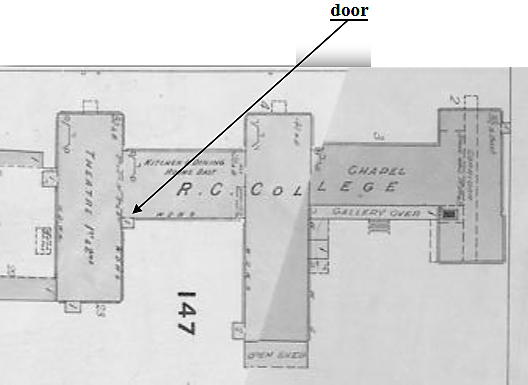
Being secretary of the college, I, of course, had the registers in my room, and after running out and sending in the alarm, I came back and attempted to reach my room on the third story. This I could not do, as the flames were rushing down the corridors, filling them with dense volumes of smoke. In attempting to reach my room, I had my hair badly singed. When I saw that evidently the building was going, I gave the alarm along the corridors, where a few of the students were still in their rooms. By this time the firemen had not yet arrived, and I telephoned the station asking them to send down all the firemen they could, that the University was going. Father Fortier, in the meantime had gone around to the fire station on Theodore Street to give the alarm. The building by this time was filled with flames and smoke in the upper stories, and all the students could do was file outside, none of them being able to return to their rooms for any of their clothes or possessions."
SHORT HISTORY OF THE UNIVERSITY
How A College Grew to Varsity-hood Steps in its Progress
Ottawa University was founded in 1848 by the Oblate Fathers under the title "College of Bytown." In 1856 it received the title of College of Ottawa together with the power of conferring university degrees.
In 1861 its charter was so amended as to extend its original powers. The first rector was Rev. Father Chevalle, O.M.I.
The college was at first only a wooden structure, but in 1862, it was transformed in the stone building now used by the Christian Brothers on Sussex Street near the Basilica. At this time Right Rev. Bishop Guigues placed Rev. Joseph Tabaret, whose statue stands in front of the ruins, in charge of the new college. An effort was made to secure the present site of the Parliament Buildings for a larger building, but failing this the present site, the gift of the late Louis Theodore Besserer, was utilized.
In 1880 the college was extended from the four-story 80 x 40 on Wilbrod Street to Cumberland Street, the east wing being erected.
Rev. Father Ryan was made president for a few years while Father Tabaret was Provincial of the Order of Oblates in Canada.
In 1879 Mgr. Duhamel, Chancellor, on a visit to Rome, brought back the degree of Doctor of Divinity for Rev. Father Tabaret. The same year saw a grand reunion of ex-students from all parts of Canada and the United States.
In 1884 the Scholasticate at Ottawa East was built and the main building was enlarged by 100 feet by 50 feet. A wing 150 x 40 was then built westward.
In January 1885, the old gymnasium was destroyed by fire. The Academic Hall was then in course of completion. The center wing was at once extended 50 feet, making it 170 feet long. The gymnasium and reading rooms, with study hall and dormitory occupied this new wing.
The college had been making a name for athletes and the College grounds, now a Varsity Oval, were taken. In 1886 Rev. Father Ph. Provost became president of the university in succession to Father Tabaret, who died suddenly in February. Ill health forced him to give up and he was succeeded by Father W. W. Bennett, who died in the February following. Rev. Father Paillier, who is still in the city, became Superior of the community and Father Holland, director of the college.
In July 1882, Rev. Celestin Augler, O. M. I., became a Provincial and appointed Rev. Father J. M. Fayard Superior.
The new chapel was then built on plans of the Very Rev. Canon Bouillon of the Archbishop's Palace.
Rev. J. J. Griffin, next established the "Owl", the college magazine, which later took the pretentious name of the University of Ottawa Review.
Rev. Father McGuckin replaced Father Fayard in 1891 as President of the University, when the grand inauguration was held. He was replaced by Rev. J. H. Constantines in 1897, who was in 1900 succeeded by the present rector, Rev. J. E. Emery.

THE INSURANCE HELD BY THE VARSITY
The total insurance for the building and contents was $250,000.00, while Father McGowan, treasurer of the college, estimates the loss at $500,000.00. The following is the list of Insurance companies as furnished by Father McGowan, the college treasurer;
Quebec – $20,000
Queen City – $10,000
Phoenix London – $10,000
Phoenix Hartford – $10,000
Alliance – $10,000
Scottish Union and National – $30,000
Economical – $10,000
Mercantile – $10,000
Ottawa – $10,000
London Mutual – $50,000
There is $50,000 insurance, of which Father McGowan could not name the companies. In addition to the companies named by the College Authorities, the Journal learns that the following companies carried insurance;
North American – $20,000
Northern – $20,000
Anglo American – $8500
Equity – $3500
HOW THE BUILDING WAS LAID OUT
The destroyed building, as shown in the illustration given herewith, made up of three wings with connecting links.

One of the links, that in the middle, was the oldest part of the building. The western wing, where the fire started, was the newest wing, except that which was added a couple of years ago as an addition to the central portion of the building. The various wings and links, counting from west to east, were occupied as follows;
West Wing – Academic Hall, study, classrooms, dormitory (top floor)
First Link (old building) – Student’s rooms, classrooms, priest’s rooms, recreation hall.
Middle Wing – Recreation Hall for students, junior study hall, class rooms and dormitory.
Eastern Link – Chapel and dormitories.
Eastern Wing – Seminary and Father Murphy’s apartments.
INCIDENTS OF THE BLAZE
LITTLE ITEMS PICKED UP AS FIRE WENT ON
Facts Not Narrated in the Report Proper. Noted From the Reporter's Books.
The fire produced many incidents which could not be told of in the regular story of the fire. The following noted picked up by the Journal reporters give a good idea of what happened.
Capt. Graham of No. 3 Fire Hall, was looking from the window of the station, when he noticed what he considered steam escaping from the windows of the first and second floors of the part of the building in which the Academic Hall was situated.

In an instant, he states, a flood of flame, twenty-five feet high, broke from the windows and at the moment an alarm from box 24 was sounded.
Father Antoine, professor of mathematics, was in the priest's refectory, when the smoke drove the reverend gentleman from the room. He tried to reach his own room where he had valuable scientific papers, but when he reached the portal, he was unable to enter.
The walls of the Chapel, which collapsed today, have been twice visited by fire. Under the added stress of today's heat, they could not withstand the pressure.

"Tod" Sloan had no remarks to make regarding his wearing apparel which was lost in the fire, but he bewailed the loss of some $13.00 which were lost in the fire and would have carried him home.
Coming from the fire the reporters met many students who already purchased winter overcoats to protect themselves against the prevailing cold weather.
Several students as soon as the fire began to demolish the structure telegraphed home for transportation.
It was understood that provisions will be made for the degree students to continue their course so that they will not be deprived of their parchments and lose a year. The Scientific Hall, the Juniorate, and the Scholasticate are available for the accommodation of those desirous of completing their course in the various departments, such as the commercial, matriculating and classical. A number of students are desirous of entering McGill and other seats of learning.

Rev. Father Emery, Superior of the University, sent a telegram to the Associated Press at an early hour to the effect that all students were safe. This was done to relieve anxiety in numerous districts in Canada and the United States where the friends of the university reside.
Among the things saved, were the football trophies which the garnet and the grey struggled on hard fought fields to gather and Nick Ra??? the star half back of the second team was instrumental in saving the pewter.
Rev. Father Murphy, Pastor of St. Joseph's Church, had all his papers and effects saved, thanks to the effort's enthusiastic parishioners. His goods are safely housed, but he does not know where, but he is of the opinion that he will regain everything.
The handball alleys, strange to say, although completely built of wood remain intact in spite of the fact, that fire raged fierce about them.
The priests' promenade gallery and the porch leading from the senior recreation hall were the last to take fire.
Rev. Murphy criticized the brigade for directing their attention to the handball alleys when St. Joseph's Church was in danger of catching fire. He thought better discretion could have been used.
In both study halls there were libraries of selective literature for the use of the students, an inconsiderable building to be entailed.
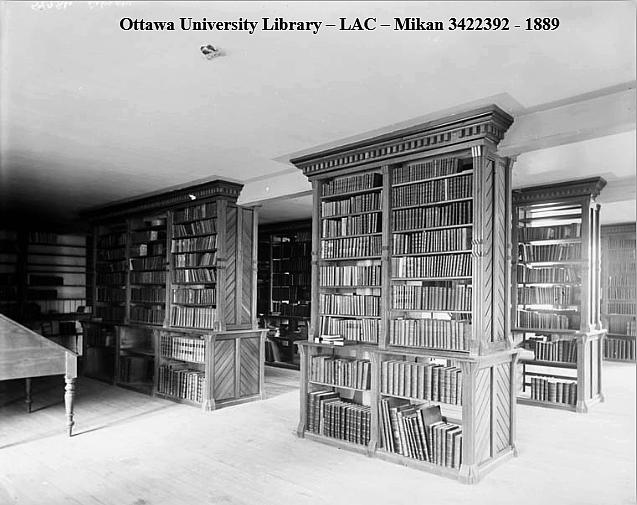
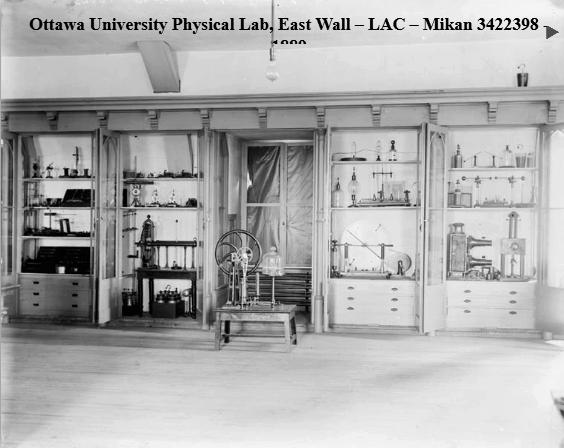

Ottawa University Physical Lab, NE Case. LAC-Mikan 3422399.

Ottawa University Museum East Case. LAC-Mikan 3422395.

Ottawa University Museum West Case. LAC-Mikan 3422396.

Ottawa University center Museum Case. LAC-Mikan 3381200.

Ottawa University Physical Lab, NW Case. LAC-Mikan 3422401.

Ottawa University Physical Lab, South End. LAC-Mikan 3422397.

Ottawa University Physical Lab, West Case. LAC-Mikan 3422400.

Ottawa University: 1st Phase of the College 1874.
Taken from Cumberland & Wilbrod Streets. LAC-Mikan 3319104.

Ottawa University: West Wing added plus centre lengthened, 1886.
Taken from Waller St. & Wilbrod St. LAC-Mikan 3421993.

In or about May 1905, Tabaret Hall was open for business, home of the Ottawa University.
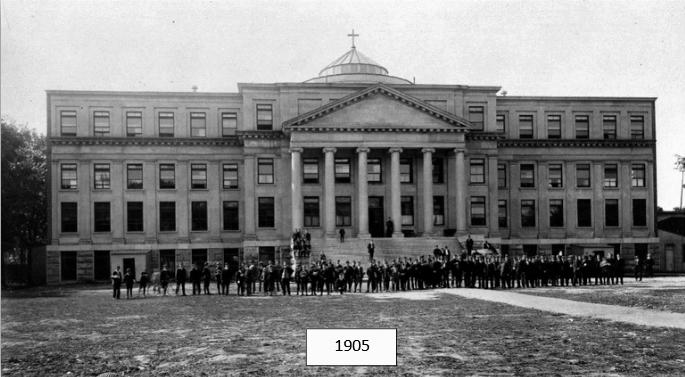
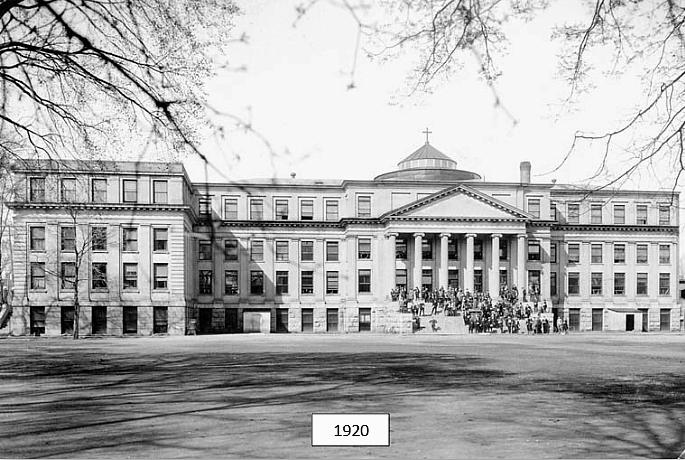
Thanks to Taylor Kennedy for this article.
Can you provide corrections or comments?
Please email Charlie Dobie.